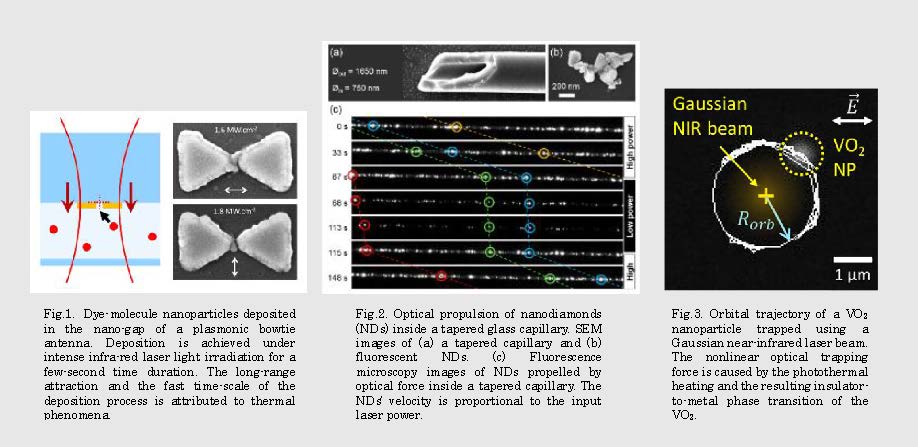RIES
Research Institute for Electronic Science, Hokkaido University
北海道大学
電子科学研究所

LAST UPDATE 2019/06/05
-
研究者氏名
Researcher Nameパン・クリストフ Christophe PIN
助教 Assistant Professor -
所属
Professional Affiliation北海道大学電子科学研究所
光科学研究部門・光システム物理研究分野
Research Institute for Electronic Science, Hokkaido University
Photonics and Optical Science division, Laboratory of Photo-System Physics -
研究キーワード
Research Keywords
Photonics
Plasmonics
Optofluidics
Optical forces
Nanoparticle trapping and manipulation
Thermoplasmonics
Vanadium dioxide
- 研究テーマ
Research Subject -
フォトニックとプラズモニックシステムを用いたナノ材料合成と光圧操作
Nanomaterial synthesis and optical manipulation using photonic and plasmonic systems
研究の背景 Background
- A large range of light-matter interactions can be harnessed to interact with nanomaterials and control their properties. Among them, optical forces result from the transfer of momentum between photons and matter, enabling optical trapping, propulsion, rotation, binding, assembly, and crystallization of nanomaterials. Understanding the mechanisms underlying these phenomena is of great interest for investigating not only light-matter interactions but also other phenomena occurring at the nanoscale.
- Photonic and plasmonic nanostructures provide unique means to tailor evanescent fields at their surface and enhance optical trapping and manipulation of nanoparticles. In addition, they can also be used to interact with nanomaterials via other nanoscale phenomena such as electrostatic forces, photothermal heating, liquid flows, hot electron generation, chemical reactions, etc. Although nanoscale systems are often complex, this complexity can be advantageously exploited for achieving unprecedented results.
研究の目標 Outcome
- Demonstration of a new technique to trap and adsorb nanoparticles in a plasmonic nanogap
- Fabrication of tapered glass micro-/nano-capillaries for optical sorting application
- Demonstration of nonlinear optical trapping of VO2 nanoparticles and resulting spin-to-orbital angular momentum conversion
- Laser-induced hydrothermal synthesis of VO2 nanostructures and nanoparticles for bottom-up nano-device fabrication
- Plasmon-assisted hydrothermal synthesis of hybrid Au@VO2 nanostructures for tunable plasmonics
- Design of plasmonic nanoantennas for nanoscale light control
研究図Research Figure

Fig.1. Dye-molecule nanoparticles deposited in the nano-gap of a plasmonic bowtie antenna. Deposition is achieved under intense infra-red laser light irradiation for a few-second time duration. The long-range attraction and the fast time-scale of the deposition process is attributed to thermal phenomena.
Fig.2. Optical propulsion of nanodiamonds (NDs) inside a tapered glass capillary. SEM images of (a) a tapered capillary and (b) fluorescent NDs. (c) Fluorescence microscopy images of NDs propelled by optical force inside a tapered capillary. The NDs’ velocity is proportional to the input laser power.
Fig.3. Orbital trajectory of a VO2 nanoparticle trapped using a Gaussian near-infrared laser beam. The nonlinear optical trapping force is caused by the photothermal heating and the resulting insulator-to-metal phase transition of the VO2.
Fig.2. Optical propulsion of nanodiamonds (NDs) inside a tapered glass capillary. SEM images of (a) a tapered capillary and (b) fluorescent NDs. (c) Fluorescence microscopy images of NDs propelled by optical force inside a tapered capillary. The NDs’ velocity is proportional to the input laser power.
Fig.3. Orbital trajectory of a VO2 nanoparticle trapped using a Gaussian near-infrared laser beam. The nonlinear optical trapping force is caused by the photothermal heating and the resulting insulator-to-metal phase transition of the VO2.
文献 / Publications
Nanophotonics (2023), J. Photochem. Photobiol. C 52, 100534 (2022), Nano Lett. 21, 6268 (2021), Nano Lett. 20, 389 (2020), ACS Appl. Nano Mater. 3, 4127-4134 (2020),
ACS Photonics 2, 1410-1415 (2020), Lab Chip 18, 1750 (2018), ACS Omega 3, 4878 (2018), ACS Photonics 2, 1410 (2015), Appl. Phys. Lett. 105, 171108 (2014)
研究者HP
- christophe.pin
 es.hokudai.ac.jp
es.hokudai.ac.jp - https://researchmap.jp/christophe.pin/